By Michel Robertson, from the book
Welcome Home, Brother: Memoirs of Vietnam War Veterans
Young Ray Pavlik had not heard of Vietnam when he graduated from high school in 1964 and enlisted in the Navy. “I wanted to get as far away from Cleveland as I could.” His proficiency in mechanics led him to school in Memphis, and then to Miramar CA.
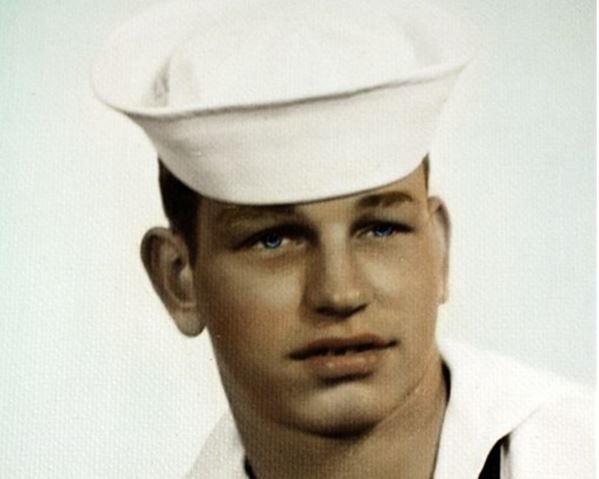
Seaman Ray Pavlik, fresh out of boot camp
Aboard a Floating City
In January 1965, Ray was assigned to the Black Lions V-F213 squadron, a unit of 112 men, including pilots, who flew and maintained twelve Phantom F-4 jet fighters capable of going anywhere at any time. Their main station was in the Gulf of Tonkin aboard the USS Kitty Hawk, playing a significant role in the Vietnam War conducting combat missions.
The Kitty Hawk was a floating city. Sitting sixty feet out of the water, drawing forty feet, the carrier weighed 80,000 tons, and spanned almost 1,100 feet long and 300 feet wide, with four catapults, three elevators, 5,000 men, two helicopters, and twelve squadrons of jets — more than 120 planes. The flight deck covered more than four-and-a-half acres.
Choreography on Deck
On the flight deck, amidst the roar of the jet engines during continuous launches and recoveries, what might have appeared to be chaos and confusion were precisely organized operations. Continuous momentum on deck required constant vigilance, and lives depended on accuracy and teamwork. Around the clock, large numbers of diversified specialists and technicians worked tirelessly to execute safe and effective launch, recovery and maintenance operations.
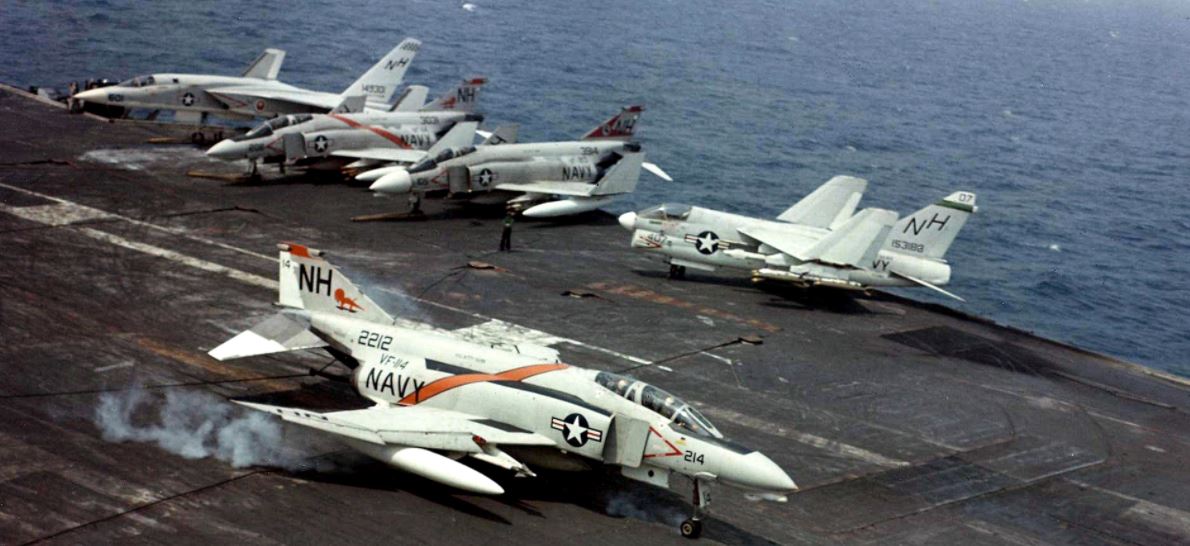
Different color shirts worn by crew members defined their responsibilities. Yellow shirts, plane handling specialists, assigned each aircraft a position on deck, conveying instructions to the pilots and directing the tractors that moved the planes. Red shirts, ordnance crews, loaded bombs onto the aircraft. Purple shirts fueled the planes with giant black hoses. And brown shirts, known as plane captains, remained on the plane, assuring that it was ready to fly at any given moment, and that every moving part in every plane was checked and double-checked. Ray was a brown shirt, or plane captain.
“Two brown shirts were assigned to every plane. Unless the plane was flying, one of the two was always in attendance, and sometimes both. We worked twelve to twenty-four hours on the plane.” Before each launch, tractors moved planes to their assigned positions. Ray stayed in the plane to apply the brakes until it was chained down, then continually checked the gauges, resupplied oxygen, and assured there was no damage to the fuselage. As planes took off and landed, yellow shirts repositioned them for the next launch. Every time a plane catapulted into the sky, those remaining on deck would be repositioned, moving forward toward the catapult.
“We fastened each plane down with up to fifteen chains because the ship never stopped rolling. When the pilot came on deck, I’d strap him in, connect the power and hose to crank the two engines and take him through his test. Then I’d unchain my plane, throw everything in a bag and walk to the side. Sometimes it was tough getting across the deck when all the planes were moving into position to launch. Often, they were less than a foot apart, with wings up.”
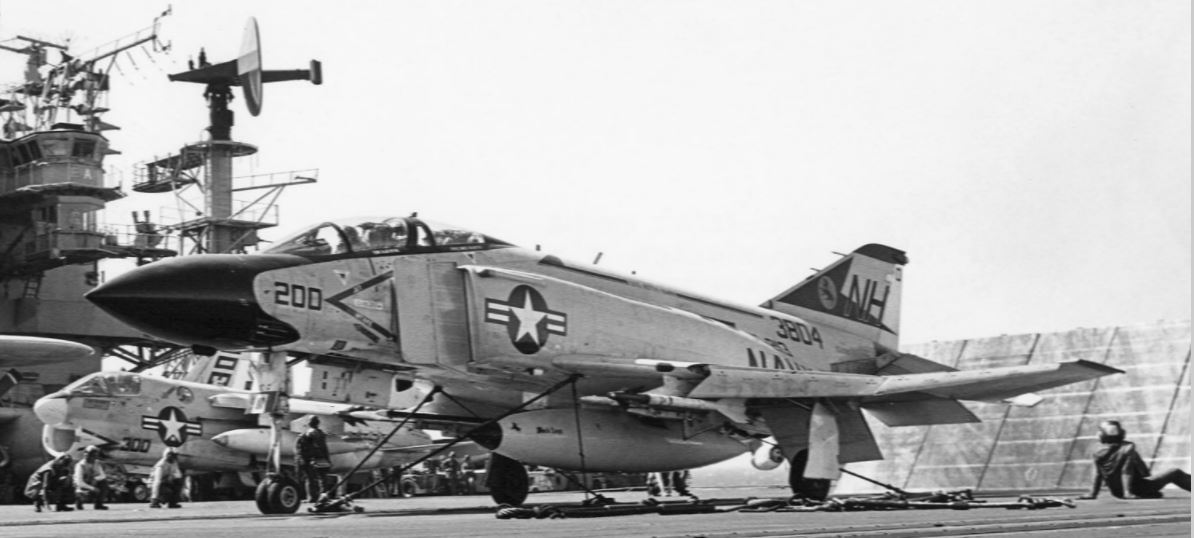
In this picture you can see the chains holding down a Black Lions F-4
“Everybody Had His Job”
During the Tet Offensive, the Kittyhawk spent more than sixty days offshore. “It was the heaviest bombardment we experienced. Every available plane was launched. There were 120 planes and sixty would take off at a time. They went out, dropped their bombs and returned.” Night and day, planes moved through an intricate routine of positioning, launching, dropping their bombs, recovery and preparing for the next launch. “In a crew of 5,000, everybody had his job. Everybody knew what he had to do to make this thing go. That’s what was so amazing.
“On one occasion, I had unchained my plane and was walking across the deck, jets moving all around me. I ducked underneath a plane to get to the other side. Just then, the yellow shirt started moving the plane. I was behind the two jet engines at that time. I hit the deck and threw down my bag of chains to hold on to and hide behind. They’re quite heavy. The initial gust of power off the two jet engines rolled me toward the A1’s on the fantail. I was able to get away quickly as the jet moved beyond me.”
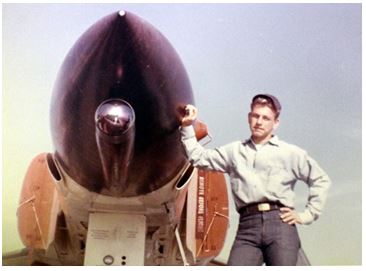
Plane Captain Pavlik with his Phantom F-4 jet fighter
In hostile waters, two jet fighters were armed and ready to launch around the clock. “One night I sat with our pilot and RIO, shooting the breeze. During the night, they were called but they didn’t return. Their plane had exploded. It was very disheartening. On my three tours with the Kitty Hawk, pilots and radar operators sustained the most casualties.”
The USS Kittyhawk was given the Navy Unit Commendation for exceptionally meritorious service of her crew during her Vietnam deployment.
Today Ray (at right) is a member of the VFW, American Legion, and the Vietnam Vets Motorcycle Club, and a valued volunteer at the Veterans History Museum.
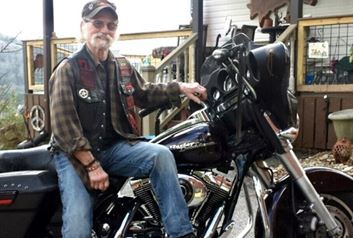
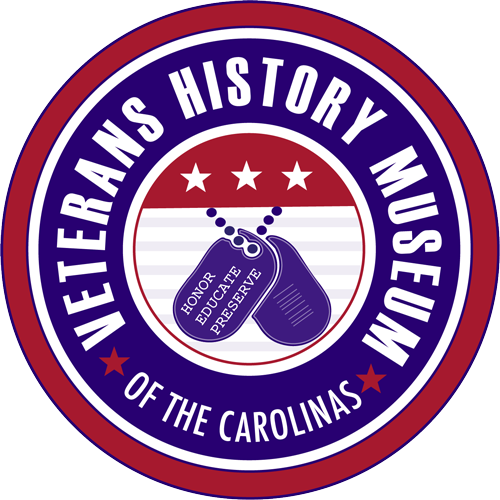
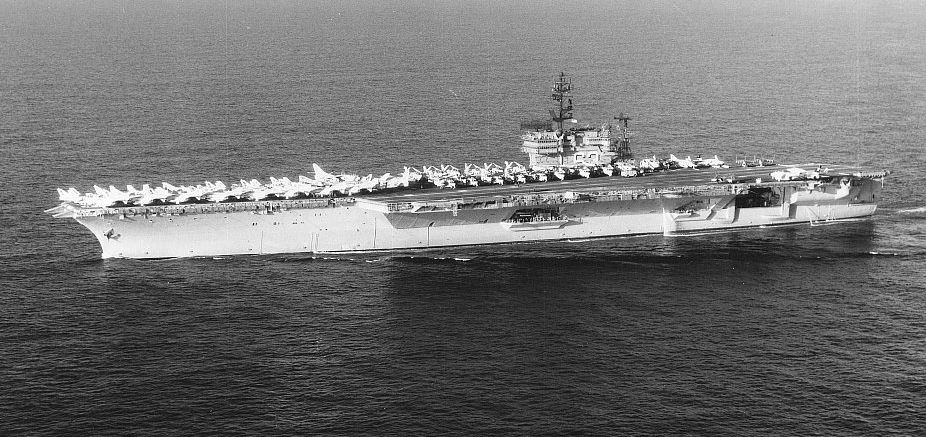
I appreciate your service. Welcome home, shipmate.
USS Oriskany,CCA
‘66-‘68
At 17 I was attached to the kittyhawk 1973
I was with the fifth Marine division touring with the US Kitty Hawk first naval fleet LSD carrierDon’t remember the name of the ship he’s had a front door on the front of it they carried tracks 1973 Our front door got taken off during a hurricane or typhoon we got stationed in the Philippines for three months while it was being repaired
Possibly USS Tuscaloosa.
Thanks for your service Ray. I was a PC on the RA5C VIGILANTE from 75-78 and was aboard Kitty Hawk also. Returned to NAS Dallas to VF201 a Reserve Phantom squadron
AQ2 pc at pax river after va65 deployment 1968
I was on board in 1970 to 73 made two deployments to Vietnam part of catapult number one crew what a experience
I remember you , I was also on Cat 1 crew
Was there fliying E-2s off Kitty Hawk with VAW-114, 1967-1970.
Flew aboard on Cod 1/10/68. Our Proud Lady is getting ready to be scrapped even though our Veterans Association was going to make her a museum. Was proud of making sure there was sufficient steam to get the aircraft off the flight deck.
What did a man back in the 60es and 70es on the uss kitty hawk do if he war a dark green shirt dress wites and blues
The “dark” green shirt could be open to interpretation as launch and recovery did get pretty dirty on a long shift either on flight deck or below decks operations. As to dress uniforms, all enlisted personal had blues for winter, and whites for summer dress code. Hope it helps you with your question. Thank you for your accuantances service on CV-63 USS Kitty Hawk
Thank you for your service Sir
BT 2 Toft
USS Kitty Hawk 1978-1984
Served in Kitty Hawk 64-67, navigation division. The F-4 phantom was my favorite aircraft. Standing mid-watch on the bridge I’d watch an F-4 launch from cat 1or 2 in full after burner white hot and then disappear in the dark at shut off. I loved that shop.
Best times of my life being aboard the U.S. kitty Hawk from 1972-1975.
Hi Eric, my name is Ed Curtis. I reported aboard the Hawk in Japan in January 28, 1978. It was the last day in port. I was assigned to 3rd division in Deck Department. I made it to only E-3. Was not a model sailor. I had quite a few AWOL and UA’s. But, durin our time, My job was to keep the ship moving by driving, fueling, bringing food aboard and ammo for our stint in the I.O. in 1979, 1980. What was the saying the Capt. kept saying after every time he spoke on the 1MC. I forgot. It was the most enjoyable and unforgettable time in my life. I just wish I had done 20 and then gotten out with a pension. Oh well. Have a nice life Eric!
Thanks for your service. I was in SAC at the time manning a Titan ICBM in Kansas doing my part.
Crewmember from 68 to 69 in Supply. Landed on Kitty Hawk in a chopper, was almost blown off deck by jet starting up as we walked across deck. Your flight deck crews were quite an organuzed team, watchibg flight deck ops at night was something else.
I’m a plank owner of the Kitty Kawk, went aboard right out of boot camp in 1960 I went around the horn and to our home port in San Diago. I made (3) trips to the Far East in the 7th fleet. Four years on the Kitty Hawk. Lots of good memories.
Served on Kitty Hawk 1970 to Dec 1972 fireman first class worked in air compressor shop 2 westpacks Vietnam great ship still think about it alot
Do any of you remember Dave Donovan ADJ AN VA65 was there in1968 69 died in a plane crash while at PAX RIVER?
Great story shipmate! I was on the USS MIDWAY! Plane Captain for VAQ-130 det 2 We flew the Whales! We had a lot of action ourselves and safety was priority one. Glad your home brother!
I think of my years on the Kitty Hawk often. It was hard times but great times as well. The comradery being together 24 hours a day was very special. I still keep in touch with several crew mates. I’m 68 now and cherish those memories.
Ray, I served on board the Hawk. 28 Jan 1978 in port Osaka, Japan on the last day. I served on board until 21 Nov. 1981. I seen 3 wes-pac, including a two month extension to the Indian Ocean during the Iranian crisis.
Shipmate landed on the Hawk by way of the mail plane, in Dec. 1978 I was in G2 Weapons served on the Hawk until 1981 as well. Shellback. Thank you for your service I remember our time in the I.O.! Tell the stories almost monthly.
I was on cv63 from 6/81 to 6/85 two Wes pac and yard period. On March 24 1984 we ran over a Russian sub. I felt old now she going to be scrap.
Great information I never knew what all the different colored shirts were but all my work was 2 nd deck and below.
I was on the uss kitty hawk from 1967 to 1970 i was a ship fitter ship company i worked all over the hawk it great to see you guy where on her the same time
Great work you do for the vets
I was on the Kitty Hawk in 1972 when Capt. Oberg made Admiral.
Miramar 66-68, shore duty, Kitty Hawk , 68-70, Ships Company and VF-114.
Didn’t I see you in Olongapo ?
Hello. My dad was aboard the Kitty Hawk when Red Carmondy was the Captain.
I believe it was 1965 . My dads name was Charles McCowan
Aka (Mac) my father loved his service aboard the Hawk.
I too started at Miramar with VF 114 Aardvarks. Four weeks plane captain school straight out of boot camp. End of October went on the Hawk to the mess decks for 3 months. Incentive for promotion to airman. 4 months later passed exam and promoted to PH 3 transfer to ship’s company to Bremerton for overhaul. Quite happy close to home. Got another transfer to RVAH 6 and back to the Hawk for another WESTPAC as a PH 2. The Hawk was the best carrier I was on. Retired as MAC after 36 years. The Hawk needs preservation as museum in Astoria, OR. They have the correct sized slip for her. See Kitty Hawk Vets Assoc web site to see the proposal.
Yes l was SP there 1971
Remember Jolos with the crocodile and ducks out front
Thanks for your service Ray. I was a jet mech on the ra5c vigilantes with RVAH11 on the 68/69 cruises. Remember seeing you many times.
Increase2010@yahoo.com
I enlisted in the Navy Feb 1977 and I’m from Canonsburg, PA.
My Bootcamp Great Lakes, Illinois (A) School Lakehurst, New Jersey.
Next thing I know I was on a floating City the USS Kitty Hawk CV63.
V-2 Division 4yrs left came back in 1984 went on West Pac got out and left
San Diego !986. I live in Columbus Ohio 43123.
Thank you for your service. I served on the Kitty Hawk from 1977 to 1979. V4 division.
on her 1989-1992 ,, grew me up
I was on the Kitty Hawk 1977 – 1979 Than I served in Puerto Rico at Roosevelt Roads. Than I came back to the Kitty Hawk in 1983 and left San Diego in 1985. ABE- 2
Was in v2 division 1976 through 1980, which is catapults and arresting gear. Good article thanks Ray for your service, wish they would turn the Kitty hawk into a museum.
I remember you I was in V2 Green shirt MD2020 nick name.
After she is scrapped will there be mementoes for sale?
Bro Gray send me a email
Increase2010@yahoo.com
Mark Davis ABE-2 V2. DIV 1977 – 1979 / 1983- 1984 2nd Westpac.
I was on the Kitty Hawk from 1991-1994. I worked in S-2 and S-5 division.
I was on the Kitty Hawk as a BT in P-1 Division, 1MMR, 1973 – 1976.
Lost 6 good Sailors in an engine room fire steaming from Hawaii to the Phillipines Wes Pac 1973/74.
RIP my brothers!
I was on KH, 72 to 75. Deck Department Yeoman. Was on board during that fire. KH was my first ship. Served with VAW 114. YN1/AW, YNC/AW. Best unit i ever served with. Retired YNCS/AW 1994, USSTRATCOM. OFFUTT AFB, Bellevue, ME
I served on her from 82-85 and loved it.. I was on the the KittyHawk when we collided with the Russian submarine. The sub hit the port side of the ship at 10.05 pm. And of course we went straight into general quarters.
Thanks to all you Kitty Hawkers! And thank you for visiting the Veterans History Museum website. We honor and celebrate all of you for your service to our country. And to those of you who served in Vietnam, welcome home.
Michel Robertson
Author, “Welcome Home, Brother”
Thanks to all you Kitty Hawkers! And thank you for visiting the Veterans History Museum website. We honor and celebrate all of you for your service to our country. And to those of you who served in Vietnam, welcome home.
Michel Robertson
Author, “Welcome Home, Brother”
I was there too I did not see your article before I replied. Yeah the Capt woods woke us up. My buddy woke me up first f Perez came to me telling me we just ran over a Russian sub. I thought he was joking at first.
Yes Jerry Lee, I was with you.
I was aboard 1965-67
OI Div (Radar)
I was aboard her at the same time. Medical. The claxon sure was loud when we hit. She was a good ship. Sorry to see her be scrapped. Capt. Rogers was a great C.O.
Tim ludlow
Tim ludlow on February 28, 2021 at 02:00
Your comment is awaiting moderation.
I served on her from 82-85 and loved it.. I was on the the KittyHawk when we collided with the Russian submarine. The sub hit the port side of the ship at 10.05 pm. And of course we went straight into general quarters.
I was in the same squadron and carrier at the same time Ray was. We knew each other.
I was one of the original commissioning crew in 1961 @ Philadelphia Naval Shipyard. Capt. William F. Bringle was the Commanding Officer.
2 years of the best duty.
I. Went to the Kitty hawk 81 to 85 nothing like Vietnam but we ran over a Russian sub
I went aboard the Hawk Sept 1965. Did Weapac 65-66 / 66-67. A lookout both cruises. Watched hundreds of launch& recoveries.Must of passed one another many times. Respected all the flight deck personel.
That was awesome
Good to see you Ray. This is Terry Barnett we spent a lot time in the Black Lions line shack together. The last cruise I made was the 66 67. Left Miramar before 213 left late 67.
Enjoyed Ray’s description of flight deck. Was CAT1 petty officer on USS KITTY HAWK. 71-72. I remember the Easter offensive of 72.non stop bombing for months, HAWK was a fighting machine,with a great crew of well trained men. Proud to have served in the USN. ABE2 Michael Geary
I served also aboard the Battlecat,
1971-72. Went through Millington, A & P School also, station with VF-121 Mirmiar, San Diego. Start of Top Gun. March 69 until joining VF-213 in January 1971
I was onboard the Hawk, i was an ordnanceman 2 in VF -213 on the 72 Westpac cruise off Yankee Station. AO 2 Rogers (Scotty) Gipson.
I was onboard the Hawk, i was an ordnanceman 2 in VF -213 on the 72 Westpac cruise off Yankee Station. Rogers (Scotty) Gipson.
I served on the kitty hawk from 1977 to 1980 it was an honor to.serve in this carrier with so much history.
Was attached to Kitty Hawk from 68-72. (VAW-114) E-2s. Wish I could do it all over again.
Ken, this is Ken Walberger, good to here from you, I miss those VAW 114 days
Great story from a fellow Kitty Hawker.
I was on the Kitty Hawk during the Tet offensive, 8 hours on 8 hours off for 60 days. I was in CIC so never a dull moment.
Served with va 75 1967 -68 PN 3 was an honor to serve.
RHIP to all who gave all
Was in V2 arresting gear 68-70. Remember grabbing a few padeyes to stop my rearward travel after getting hit with a jet blast on a few occasions.
Hi Ray. I was on the Kitty Hawk from 1962 through Nov. 1964. I was attached to GDiv. Worked on the flight deck. Most memorable time as a side bouy for Kennedy.
I served on this ship from 91-94 and called her home. Lots good memories made with a lot of great people.
Thanks for your service. I was serving on Kitty Hawk 64-67 in navigation division same time your squadron was aboard.
Was an E-2 pilot in VAW-114 on board 1967-1970. What memories of those times and the men I served with. Alas Kittyhawk is in dry dock for her final time in Bremerton to be soon towed to be dismantled in Texas.
Was E-2 aviator in VAW- 114 aboard Kittyhawk from 1967-1970. I remember being with some pretty remarkable guys.
Too bad Kittyhawk is about to make her final voyage from Bremerton to Brownsville, TX.
March 7, 2021, my name is Fred Oakley, served aboard Kitty Hawk (Cva63) 1966-1970, as a quartermaster, navigation, it was a honor to serve aboard this ship with all who served.
I was on the Kitty hawk 72 to 75two wespacs the boiler blew up Dec 11 1973 6 deaths the next cruise we were taking on water
I really wish the Carolinas could have done something to preserve the KittyHawk! A museum or something to keep the old girl running. My home in V2 Div., Cats and Gear, I got to work both! April 75 to August 78.
I was in V2 Div., Cats the people in the Gear never sleep very long.
77-80
VA 112 66-68 line crew
I turned 18 on the USS Kitty Hawk February 1975, in the mist of a RIM PAC. As a plane captain with VA-195, I spend most of 1975 aboard the Hawk. I experienced a lot incidents that year as a 17, 18 teen year old. I went on to serve 12 years of active duty.
Hi Terry
My name is Dave Fitzpatrick, I was in VA 195 from 1973 – 1/77 in airframes (AMS 2) I’ve kept in touch with a couple of guys – Vic Grosso & Dave Larson from Personal.
I did my 4 then stayed in Reserves with VP 64 where I retired from in 93.
Hope life has treated you well. I’d love to hear back from you.
Those were very special times. Cubie Point , Subic Bay , Olongapo.
All the best
Dave
Subic and the fleet was in SanMigel 3 liner at Jolos with the crocodile out front.
Hi Terry
My name is Dave Fitzpatrick and served with you in VA 195. I was there from 1973-1/77 in airframes (AMS-2). Great memories. I keep in touch with Vic Grosso and Dave Larson from Personal.
Hope your life is a good one. I would love to hear back from you.
Dave
Hi Terry
I served with you in VA 195. Would love to hear back from you.
Dave
Served on the hawk 70-72 boatswain mate 1st division
I served from 76 to79 started in Bremerton dry dock worked in 4 main 2 boilers 1 1500 kilowatt generator #4 main engine 1200 psi to make ship go and to launch jets 1 westpac had a great time love the far east kitty hawk awesome
Served on board from72-74 in P-3. Made PQS E.O.O.W. while serving. Kitty Hawk was my last tour at sea duty as I retired while at FMAG in 76.
My dad was on the hawk,71-73? Ruffly, senior chief Cantrell ,he just past, last year, many stories,
In 1973 I was stationed on the Kittyhawk, during dry dock, converting it from CVA to CV- nuclear.
67 – 69 I served as an aviation electricians mate with VF213 aboard the USS Kitty Hawk. Proud to have served.
Did you have any shipmates on Forrestall?RIP 134
1960-62 “B” Div. Oil Shack
served on the hawk 67/68 west pac , with va75, flight deck t/s, best years of my time in the navy.
Big fun on each port stop-especially n Australia (oh boy).
Great friends and great times. Worked in CIC area; w/great folks.
I’d ride again if I was much , much younger (😂😂).
Fair Winds and Following Seas, SHIPMATES
Really miss Fosters and San Migel those Aussies make some great brew!!!
Wow great reads. I was on the kitty from 92 to 94 deck dept 2nd division. Spent lots of time on the helm….nothing like being in control of an 86,000 ton beast I thought at the time only being in my early 20’s. Did I mention high speed rudder excercises? HAH
Carry on Smartly!
My dad was on the Kittyhawk From 77- 81 He was an MM 2.
Hi Eric, my name is Ed Curtis. I reported aboard the Hawk in Japan in January 28, 1978. It was the last day in port. I was assigned to 3rd division in Deck Department. I made it to only E-3. Was not a model sailor. I had quite a few AWOL and UA’s. But, durin our time, My job was to keep the ship moving by driving, fueling, bringing food aboard and ammo for our stint in the I.O. in 1979, 1980. What was the saying the Capt. kept saying after every time he spoke on the 1MC. I forgot. It was the most enjoyable and unforgettable time in my life. I just wish I had done 20 and then gotten out with a pension. Oh well. Have a nice life Eric!
Was on the Hawk during the Iran crisis. 79-80. Good ship.
I was in V-2 Division at that time.
Me to on board from 72 through 75 worked in ag was fly three talker
David Switzer
63-64 WestPac
Was a PR in VA-112.
We flew an A-4, Sky Hawk.
An Awsome Bird.
In 64-65 we made an Med Cruse. CVA-59 !
I would hook up that Bird to the shuttle
Good thing you weren’t on the Zippo then!!!
My youngest son, Chris Wooten served aboard the KITTYHAWK during the Gulf War. He was part of the purple group, they called themselves “the grapes” He became good friends with Neil Haveman who also served aboard the KITTYHAWK. My husband & I are planning to watch it being brought into the Port of Brownsville. Bittersweet 😪
Served on board kitty hawk west pac 85 with va165 boomers a6. Great memories and great crews
Every carrier from the Forrestal CV59 to the GHW Bush CVN77 has had 4 elevators, from the Kitty Hawk CV63 onwards they were 2 starboard ahead of the island, and 1 each side behind it. Also, someone mentioned converting the Kitty Hawk from CVA to “CV-nuclear” – no US warships have ever been converted from fossil fuel to nuclear, nor vice versa. They have armed/disarmed with atomic/nuclear weapons, but usually without redesignation (SSBNs to SSNs or SSGNs the main exceptions).
Ray, I served on the Hawk , attached to RVAH13 as a plane captain on two cruises, 65-66 & 66-67. There was an F4 line shack across the passageway from ours. Don’t know if it was 213 or 114, either way, we bumped elbows at sometime or other. Good article, thanks for the memories.